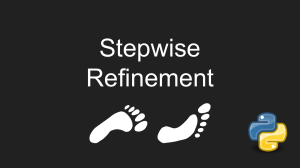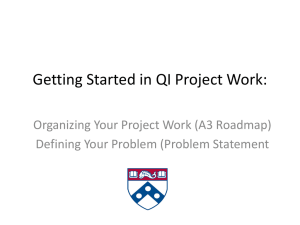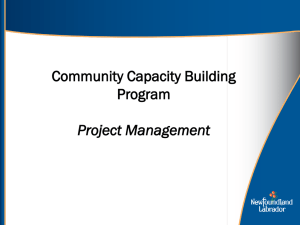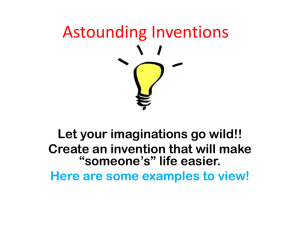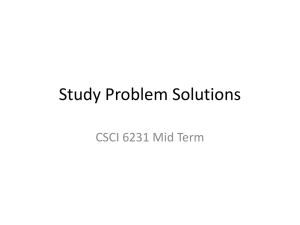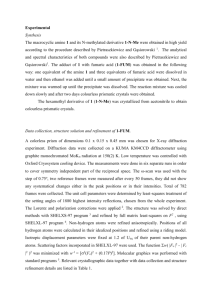Monday 3rd Oct 2011
advertisement
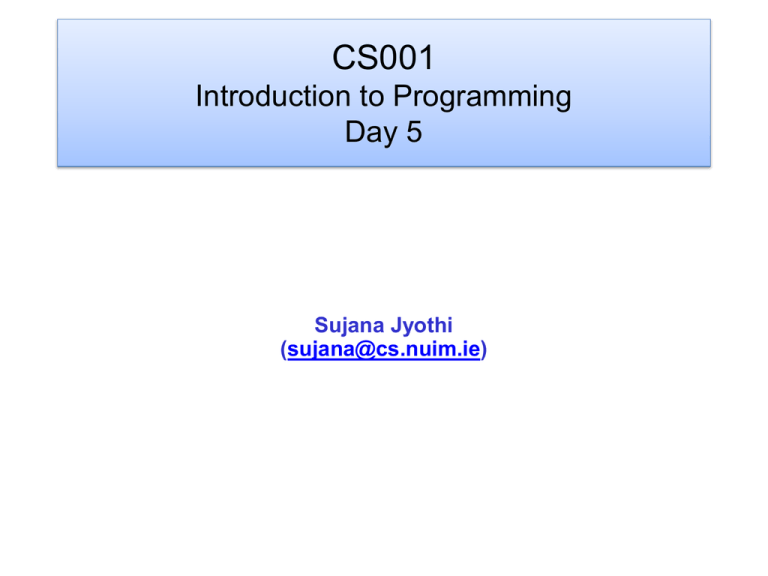
CS001
Introduction to Programming
Day 5
Sujana Jyothi
(sujana@cs.nuim.ie)
What will you learn today?
• Algorithm Development
• Stepwise refinement
2
Algorithm Development
In order for a computer to carry out some task, it has to be supplied
with a program, which is an implementation of an algorithm.
The most widely used notations for developing algorithms are
flowcharts and pseudo-code.
• A flowchart is a diagram containing lines representing all the
possible paths through the program.
• Pseudo-code is a form of “stylized” (or “structured”) natural
language.
Algorithm Development
Algorithm Development
The designer of an algorithm must ensure:
• Preciseness of the algorithm (no ambiguities)
• All possible circumstances are handled
• The algorithm is executable
• Termination of the algorithm
Stepwise refinement
• Break a complex problem down into a
number of simpler steps, each of which can
be solved by an algorithm which is smaller and
simpler than the one required to solve the
overall problem.
• Refinement of the algorithm continues in this
manner until each step is sufficiently detailed.
— Refinement means replacing existing steps
/instructions with a new version that fills in
more details.
Stepwise refinement
Example: Making tea. Suppose we have a robot
which carries out household tasks. We wish to
program the robot to make a cup of tea. An
initial attempt at an algorithm might be:
• 1. Put tea leaves in pot
• 2. Boil water
• 3. Add water to pot
• 4. Wait 5 minutes
• 5. Pour tea into cup
Stepwise refinement
• These steps are probably not detailed enough
for the robot. We therefore refine each step
into a sequence of smaller steps:
1. Put tea leaves in pot might be refined to
1.1 Open box of tea
1.2 Extract one spoonful of tea leaves
1.3 Tip spoonful into pot
1.4 Close box of tea
Stepwise refinement – contd.
2. Boil water might be refined to
2.1. Fill kettle with water
2.2 Switch on kettle
2.3 Wait until water is boiled
2.4 Switch off kettle
5. Pour tea into cup might be refined to
5.1. Pour tea from pot into cup until cup is full
Stepwise refinement – contd.
Some of the sub-algorithms need further
refinement. For example, the step
2.1. Fill kettle with water could be refined to
2.1.1. Put kettle under tap
2.1.2. Turn on tap
2.1.3. Wait until kettle is full
2.1.4. Turn off tap
Stepwise refinement – contd.
• The above algorithm consists of a sequence of
steps, each of which will be executed exactly
once and in order – termination of the last
step implies termination of the algorithm.
However, algorithms with only sequences of
steps can’t do much…
— Example: What happens if the tea-box is
empty?
Stepwise refinement – contd.
If the tea-box is empty we wish to specify an
extra step:
• Get new box of tea from cupboard
We can express this by rewriting step 1.1 as
1.1.1. Take tea box from shelf
1.1.2. If box is empty
then get new box from cupboard
1.1.3. Remove lid from box
(More complicated conditions can use AND, OR, NOT)
Events
Stepwise approach to
programming through Scratch
/* Hello World program */
#include<stdio.h>
main()
{
printf("Hello World");
}
Statement
Boolean Expression
Conditions
Looping
Variables
1
(true)
Example to add two numbers
Write an algorithm to add two numbers. The
numbers should be taken from the keyboard and
stored in variables.
http://www.youtube.com/watch?v=7O4X8DB5H8o
